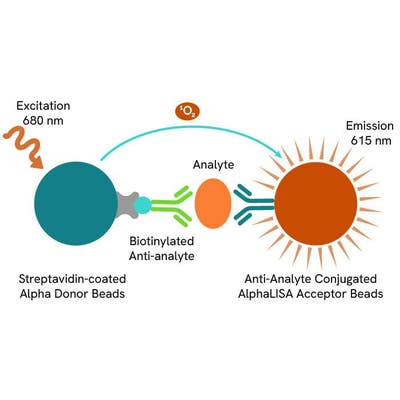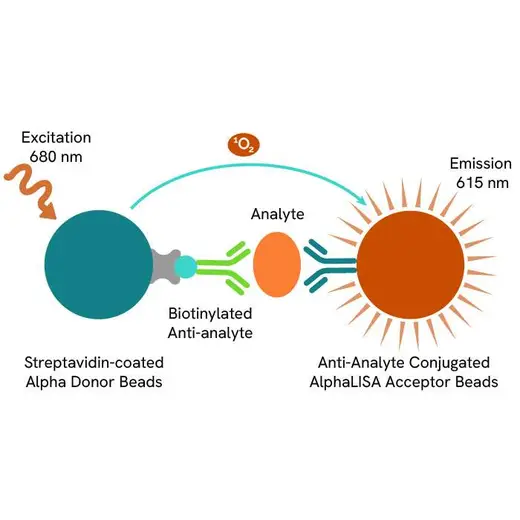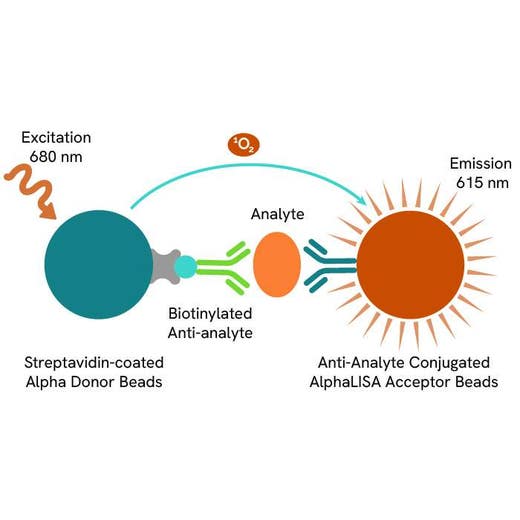
AlphaLISA Human & Mouse Fibronectin Detection Kit, 100 Assay Points


AlphaLISA Human & Mouse Fibronectin Detection Kit, 100 Assay Points






The AlphaLISA™ immunoassay kit for human and mouse fibronectin enables the quantitative determination of human fibronectin in buffer, cell culture media, serum, cell lysates and cell supernatants using a homogeneous AlphaLISA assay (no wash steps).
For research use only. Not for use in diagnostic procedures. All products to be used in accordance with applicable laws and regulations including without limitation, consumption and disposal requirements under European REACH regulations (EC 1907/2006).
| Feature | Specification |
|---|---|
| Application | Protein Quantification |
| Dynamic Range | 210 - 3,000,000 pg/mL |
| Limit of Detection | 210 pg/mL |
| Limit of Quantification | 773 pg/mL |
| Sample Volume | 10 µL |
The AlphaLISA™ immunoassay kit for human and mouse fibronectin enables the quantitative determination of human fibronectin in buffer, cell culture media, serum, cell lysates and cell supernatants using a homogeneous AlphaLISA assay (no wash steps).
For research use only. Not for use in diagnostic procedures. All products to be used in accordance with applicable laws and regulations including without limitation, consumption and disposal requirements under European REACH regulations (EC 1907/2006).



AlphaLISA Human & Mouse Fibronectin Detection Kit, 100 Assay Points



AlphaLISA Human & Mouse Fibronectin Detection Kit, 100 Assay Points



Product information
Overview
Fibronectin is a high-molecular weight glycoprotein of the extracellular matrix that binds to integrins, collagen, fibrin, and heparan sulfate proteoglycans. The fibronectin protein is produced from a single gene, but alternative splicing of its pre-mRNA leads to the creation of several isoforms. Fibronectin occurs in two main forms, plasma and cellular FN. Fibronectin plays a role in cell adhesion, growth, migration, and differentiation. Altered fibronectin expression, degradation, and organization is associated with numerous pathologies, including cancer, arthritis, and fibrosis.
Formats
- Our 100 assay point kit allows you to run 100 wells in 96-well format, using a 100 µL reaction volume (10 µL of sample).
- Our 500 assay point kit allows you to run 500 wells in 96-well or 384-well format, using a 50 µL reaction volume (5 µL of sample).
- Our 5,000 assay point kit allows you to run 5,000 wells in 96-well or 384-well format, using a 50 µL reaction volume (5 µL of sample).
Features
- No-wash steps, no separation steps
- ELISA alternative technology
- Sensitive detection
- Broad sample compatibility
- Small sample volume
- Results in less than 3 hours
- Half the time of an ELISA assay
AlphaLISA technology allows the detection of molecules of interest in a no-wash, highly sensitive, quantitative assay. In an AlphaLISA assay, a biotinylated anti-analyte antibody binds to the Streptavidin-coated Donor beads while another anti-analyte antibody is conjugated to AlphaLISA Acceptor beads. In the presence of the analyte, the beads come into close proximity. The excitation of the Donor beads causes the release of singlet oxygen molecules that triggers a cascade of energy transfer in the Acceptor beads, resulting in a sharp peak of light emission at 615 nm.
Specifications
| Application |
Protein Quantification
|
|---|---|
| Automation Compatible |
Yes
|
| Brand |
AlphaLISA
|
| Detection Modality |
Alpha
|
| Dynamic Range |
210 - 3,000,000 pg/mL
|
| Limit of Detection |
210 pg/mL
|
| Limit of Quantification |
773 pg/mL
|
| Product Group |
Kit
|
| Sample Volume |
10 µL
|
| Shipping Conditions |
Shipped in Blue Ice
|
| Target |
Fibronectin
|
| Target Class |
Biomarkers
|
| Target Species |
Human
Mouse
|
| Technology |
Alpha
|
| Unit Size |
100 Assay Points
|
Video gallery

AlphaLISA Human & Mouse Fibronectin Detection Kit, 100 Assay Points

AlphaLISA Human & Mouse Fibronectin Detection Kit, 100 Assay Points

Resources
Are you looking for resources, click on the resource type to explore further.


How can we help you?
We are here to answer your questions.






























